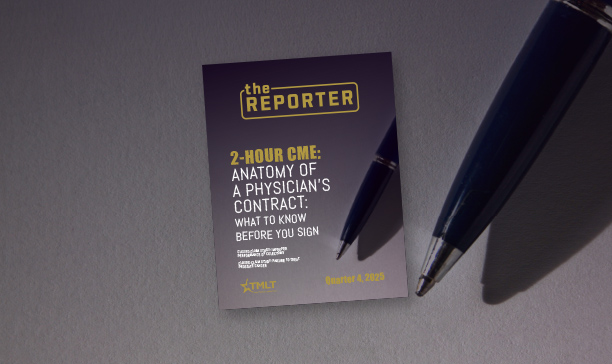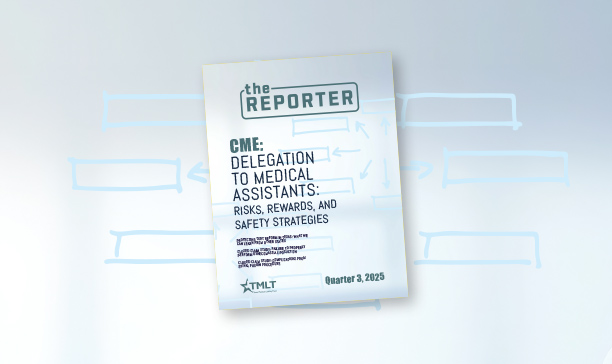Misdirected test results
A woman came to a clinic reporting a persistent cough.The patient was a smoker and had a history of COPD.
Presentation
A 67-year-old woman came to a walk-in clinic reporting a cough. The cough had persisted for a week; was made worse with exertion; was described as moderate to severe; and was productive and blood tinged. The patient also reported chills, dyspnea, dyspnea on exertion, fatigue, fever, pleuritic pain, and a sore throat. The patient was a smoker and had a history of COPD. She was also thin, with a BMI of 16.6.
Physician action
An internal medicine (IM) physician saw the patient and diagnosed COPD with acute exacerbation and acute bronchitis. She ordered an HRCT scan of the thorax, a chest x-ray, and prescribed levofloxacin, dextromethorphan and guaifenesin, and a tiotropium bromide inhaler.
This note was signed at 5:30 p.m. on October 17.
The chest CT was performed the next day at a nearby hospital. The indications for the procedure, as noted by the IM physician, were “COPD, smoker, 30 years, cough.” A radiologist read the scan and dictated the following in his report at 10:23 a.m. on October 18:
“Suspicious mass in the left lower lobe as above. This lesion would be amenable to CT-guided biopsy. There is a smaller subpleural soft tissue nodule in the posterior aspect of the right lower lobe. A small parapneumonic effusion is present.”
The radiology report was faxed to the hospital and to the IM physician’s office at 11:35 a.m. on October 18. The IM physician’s office did not receive the faxed report. There was no follow-up on the October 18 CT scan, either by the patient or the IM physician.
Eighteen months passed. The patient went to another urgent-care clinic with concerns that she had pneumonia. A CT scan was ordered and the report noted the lung nodule. The patient was referred to a pulmonologist. A biopsy revealed squamous cell carcinoma of the lung. The
patient was diagnosed at Stage IV and was treated with chemotherapy.
Allegations
A lawsuit was filed against the IM physician, the hospital where the CT scan took place, the radiologist who read the CT scan, and his radiology group. The allegations were:
- failure to follow up on the patient’s CT scan (IM physician);
- failure to communicate the suspicious findings on the CT to the ordering physician (radiologist);
- failure to have policies and procedures in place to ensure that critical findings are timely and appropriately reported to ordering physicians (radiology group); and
- failure to ensure the critical finding from the CT was reported to the IM physician (hospital).
The plaintiffs further alleged that the delay in the diagnosis and treatment of the patient’s lung cancer resulted in limited treatment options and a less favorable outcome.
Legal implications
Physicians who reviewed this case stated that the radiologist appropriately read the scan and timely dictated the report. The report was faxed to the hospital, as required by the contract between the hospital and the radiology group. The report was also faxed to the IM physician at the walk-in clinic. However, during the investigation of this case, it was discovered that the
radiology group faxed the CT scan report to the wrong fax number. It was sent to the walk-in clinic’s old fax number, so the IM physician did not receive it.
The hospital — which was contractually obligated to forward radiology reports to ordering physicians — did not attempt to forward the report to the walk-in clinic. The reason for this was unclear.
While acknowledging that the IM physician clearly did not receive the report, physician reviewers were critical that he did not follow up on the test that he ordered. The IM physician also believed that he should have followed up on the results of the CT scan.
Patient responsibility was a factor in this case. The patient did not follow up on the CT scan, as she testified that she assumed it was “okay” since she did not hear back from the walk-in clinic. Also, the patient likely had comparative responsibility for her condition relative to her long history of cigarette smoking.
Regarding causation, the defense oncology expert stated that the patient was likely at stage IV when the October 18 CT scan occurred. Consequently, earlier intervention may not have changed the patient’s treatment, prognosis, or outcome. The plaintiff’s oncology expert was not definitive about the patient’s staging on October 18. He stated there was evidence of metastasis on the October 18 scan, and it appeared the lesion did not grow much over an 18-month period.
There was discussion among the radiologists who reviewed this case about whether the defendant radiologist should have called the IM physician to report the results of the scan. Those who stated the radiologist should have called cited the American College of Radiology
Practice Parameter for the Communication of Diagnostic Imaging Findings. (1) Conversely, the defendant stated that the scan was a non-urgent outpatient study. The findings — in a patient with COPD and a 30-pack year smoking history — were not unexpected. She did not believe the
standard of care required her to pick up the phone.
Disposition
This case was settled on behalf of the IM physician. The hospital also settled their case. The case against the radiologist and the radiology group was dropped.
More on diagnostic errors
Risk management for radiologists
Disclaimer
Presentation
A 67-year-old woman came to a walk-in clinic reporting a cough. The cough had persisted for a week; was made worse with exertion; was described as moderate to severe; and was productive and blood tinged. The patient also reported chills, dyspnea, dyspnea on exertion, fatigue, fever, pleuritic pain, and a sore throat. The patient was a smoker and had a history of COPD. She was also thin, with a BMI of 16.6.
Physician action
An internal medicine (IM) physician saw the patient and diagnosed COPD with acute exacerbation and acute bronchitis. She ordered an HRCT scan of the thorax, a chest x-ray, and prescribed levofloxacin, dextromethorphan and guaifenesin, and a tiotropium bromide inhaler.
This note was signed at 5:30 p.m. on October 17.
The chest CT was performed the next day at a nearby hospital. The indications for the procedure, as noted by the IM physician, were “COPD, smoker, 30 years, cough.” A radiologist read the scan and dictated the following in his report at 10:23 a.m. on October 18:
“Suspicious mass in the left lower lobe as above. This lesion would be amenable to CT-guided biopsy. There is a smaller subpleural soft tissue nodule in the posterior aspect of the right lower lobe. A small parapneumonic effusion is present.”
The radiology report was faxed to the hospital and to the IM physician’s office at 11:35 a.m. on October 18. The IM physician’s office did not receive the faxed report. There was no follow-up on the October 18 CT scan, either by the patient or the IM physician.
Eighteen months passed. The patient went to another urgent-care clinic with concerns that she had pneumonia. A CT scan was ordered and the report noted the lung nodule. The patient was referred to a pulmonologist. A biopsy revealed squamous cell carcinoma of the lung. The
patient was diagnosed at Stage IV and was treated with chemotherapy.
Allegations
A lawsuit was filed against the IM physician, the hospital where the CT scan took place, the radiologist who read the CT scan, and his radiology group. The allegations were:
- failure to follow up on the patient’s CT scan (IM physician);
- failure to communicate the suspicious findings on the CT to the ordering physician (radiologist);
- failure to have policies and procedures in place to ensure that critical findings are timely and appropriately reported to ordering physicians (radiology group); and
- failure to ensure the critical finding from the CT was reported to the IM physician (hospital).
The plaintiffs further alleged that the delay in the diagnosis and treatment of the patient’s lung cancer resulted in limited treatment options and a less favorable outcome.
Legal implications
Physicians who reviewed this case stated that the radiologist appropriately read the scan and timely dictated the report. The report was faxed to the hospital, as required by the contract between the hospital and the radiology group. The report was also faxed to the IM physician at the walk-in clinic. However, during the investigation of this case, it was discovered that the
radiology group faxed the CT scan report to the wrong fax number. It was sent to the walk-in clinic’s old fax number, so the IM physician did not receive it.
The hospital — which was contractually obligated to forward radiology reports to ordering physicians — did not attempt to forward the report to the walk-in clinic. The reason for this was unclear.
While acknowledging that the IM physician clearly did not receive the report, physician reviewers were critical that he did not follow up on the test that he ordered. The IM physician also believed that he should have followed up on the results of the CT scan.
Patient responsibility was a factor in this case. The patient did not follow up on the CT scan, as she testified that she assumed it was “okay” since she did not hear back from the walk-in clinic. Also, the patient likely had comparative responsibility for her condition relative to her long history of cigarette smoking.
Regarding causation, the defense oncology expert stated that the patient was likely at stage IV when the October 18 CT scan occurred. Consequently, earlier intervention may not have changed the patient’s treatment, prognosis, or outcome. The plaintiff’s oncology expert was not definitive about the patient’s staging on October 18. He stated there was evidence of metastasis on the October 18 scan, and it appeared the lesion did not grow much over an 18-month period.
There was discussion among the radiologists who reviewed this case about whether the defendant radiologist should have called the IM physician to report the results of the scan. Those who stated the radiologist should have called cited the American College of Radiology
Practice Parameter for the Communication of Diagnostic Imaging Findings. (1) Conversely, the defendant stated that the scan was a non-urgent outpatient study. The findings — in a patient with COPD and a 30-pack year smoking history — were not unexpected. She did not believe the
standard of care required her to pick up the phone.
Disposition
This case was settled on behalf of the IM physician. The hospital also settled their case. The case against the radiologist and the radiology group was dropped.
More on diagnostic errors
Risk management for radiologists
Disclaimer
Want to save this article for later?
Download the full issue as a PDF for future reference or to share with colleagues.
Subscribe to Case Closed to receive insights from resolved cases.
You’ll receive two closed claim studies every month. These closed claim studies are provided to help physicians improve patient safety and reduce potential liability risks that may arise when treating patients.
Related Resources
Discover more insights, stories, and resources to keep you informed and inspired.






